Amazon sellers have to make a few choices before selling their products through the largest online shopping marketplaces in the world. Choosing between FBA and FBM fulfillment methods is probably the most challenging option there. Fulfilled by Amazon (FBA) and Fulfilled by Merchant (FBM) come with their fair share of pros and cons.
Based on a few factors, such as the product to sell and the infrastructure you have, FBA or FBM would be suitable for your business. While those variables exist, you should have a clearer idea of FBA vs. FBM. In this ultimate showdown guide, we have compared everything you want to know about FBA and FBM. We have also looked at some special sections like SFM. Before we compare FBA with FBM, we have to understand what they are.
Introduction to FBA vs FBM
What Is Amazon FBA?
FBA refers to Fulfillment by Amazon, which means Amazon itself fulfills the orders. Instead of just connecting the buyer to the seller, Amazon takes service into its hands. In this fulfillment method, Amazon will store the products in its fulfillment servers.
How Does Amazon FBA Work?
When a user places an order, Amazon will pick the product from Amazon’s fulfillment centers, pack the same, and relay the package to the shipping network. As you know, Amazon has built an effective product shipping network all across the world.
Therefore, the product will reach the customer in the fastest way possible. In most cases, customers can avail of two-day or one-day shipping if the product is available via FBA.
Customers can access the order and shipping details from Amazon’s Orders page. As an Amazon seller, you may find that FBA is the easiest way to sell a product on Amazon. All they have to do is ship the inventory to Amazon warehouses.
After that, Amazon and its networks will take care of the rest. However, you may have to pay FBA fees to Amazon.
What Is FBM?
FBM refers to Fulfillment by Merchant, which means the merchant has to fulfill the orders. In FBM, Amazon works as an intermediary between the buyer and the seller. This fulfillment method does not use Amazon’s inventories or shipping network.
How Does FBM Work?
When a user places an order, Amazon will notify the seller and provide the necessary details. The merchant now has to pick up the product and pack it. Then, it may use a third-party shipping service like FedEx, USPS, UPS, or DHL to send the product to the customer.
The customer may be able to track the details from their Amazon dashboard. Alternatively, they may receive a third-party tracking number.
However, not all merchants and shipping services may integrate with Amazon. As a result, you cannot find many cases of quick delivery options, either (more on that later.)
FBM also means that the merchant has a better level of control over the shipping process. You can also stay away from FBA fees and other payments
Differences Between FBA and FBM

Now that you know the basics about Amazon FBA and FBM as two fulfillment method options, shall we explore the differences? We have split this area into five subsections: Inventory, Packaging, Shipping, Paperwork, and Amazon Prime Participation. We hope this head-to-head comparison will help you understand the FBA vs. FBM debate.
Amazon FBA Vs FBM: Inventory
- FBA
While using Fulfillment by Amazon, the Amazon sellers do not have to worry about the inventory. The FBA sellers would have an option to pack the product as per standards and ship it to Amazon’s fulfillment centers and warehouses.
From this point, Amazon will take care of the product inventory. Once someone has bought your product via Amazon, you will receive the funds for the same to your account. Of course, you will have to pay the selling and shipping fees to Amazon in addition to storage fees.
- FBM
On the other hand, when using Fulfillment by Merchant, the Amazon seller has to maintain the inventory. Therefore, you have to keep track of the products and their information. Whenever someone makes an order, you will have to pick the product from the stock and forward it to the shipping network.
You may receive the funds through the Amazon seller account, but you do not have to pay the shipping costs. Instead, you have to keep track of fulfillment on your own.
Amazon FBA Vs. FBM: Packaging
- FBA
You have to be careful about packaging while using Fulfillment by Amazon. Amazon’s fulfillment centers are designed for maximum efficiency and space utilization. Therefore, you have to pack the product in the best way. With that being said, you do not have to worry about the outer-layer packaging of the product.
Amazon warehouses will use experienced employees and AI-enabled systems to choose the best outer-layer packaging for your product. It means your product will reach the buyer with minimal impact whatsoever.
- FBM
The seller has more freedom over packaging while using Fulfillment by Merchant. In this case, the seller does not have to comply with any standard from Amazon or the fulfillment centers. However, they may have to comply with the standards set by the shipping network/company.
Based on these standards, the seller will pack the product and push it to the Shipping belt. Some shipping companies may offer packaging services, but they may not be as cost-effective or efficient as Amazon’s.
Amazon FBA Vs. FBM: Shipping
- FBA
Sellers who use Fulfillment by Amazon do not have to worry about shipping. Amazon takes complete care of shipping the product. So, rest assured, your product will reach the customer within the stipulated time. As we said earlier, the shipping network of Amazon is awe-inspiring.
It means the seller can focus on selling the product without worrying about the logistics part of things. By the way, sellers will have to pay a fee to Amazon for the storage and shipping, which can be pretty high depending on the product.
- FBM
Sellers who use Fulfillment by Merchant have a few more options. First, they can use one of the many logistics options from the market. FedEx, DHL, USPS, and UPS are some of the available options. Or, they can use a custom-made shipping service made for their products.
Sellers also choose multiple shipping options based on the nature and weight of the product. Having this choice is quite important since it can reduce the money spent on packaging and shipping.
Amazon FBA Vs. FBM: Paperwork
- FBA
Minimal paperwork is another significant reason why many sellers prefer FBA over FBM. As we said, once you have signed an agreement with Amazon, there are fewer things to worry about. You have to make sure the products are available at Amazon warehouses.
Amazon will take care of everything else. So, the seller does not have to deal with paperwork every time a product is shipped. Because Amazon has optimized these aspects way earlier, there is no loss of productivity, either.
- FBM
On the other hand, FBM will make you involved in more paperwork. As we said, you will have to choose the shipping partner(s) based on the product. There are options to automate the process, but you will have to deal with data reports and invoices for individual products/transactions.
Therefore, fulfillment by merchants may involve more paperwork than usual. More importantly, it would be best if you had more human power to go through and streamline all this data.
Amazon Prime Participation
- FBA
Products that are sold via FBA are automatically added to Amazon Prime. It means customers can order the product and get it delivered within one or two days. As long as you comply with the packing standards from Amazon and supply stock as per demand, Amazon Prime participation will help you increase the number of sales.
After all, people love to get their products delivered faster and with minimal impact, correct? An order Fulfilled by Amazon checks all these boxes.
- FBM
Usually, products sold via FBM do not have Amazon Prime participation. It happens because Amazon does not handle the shipment, and it cannot ensure a quicker delivery time. Therefore, customers may think twice before getting a non-Prime product from the store. There are a couple of variables here, but the lack of Prime participation may reduce sales.
Experts say that the absence of the Prime sign can be less appealing for a lot of customers. However, there could be a way out around this.
Seller Fulfilled Prime Requirements for FBM
Amazon has recently launched a program called SFP, which stands for Seller Fulfilled Prime. This new system allows sellers to be a part of Prime shipping by optimizing their shipping speed and efficiency.
That is, if a seller can deliver the product as quickly as Amazon can, the seller could be eligible for SFP. First, however, the seller must meet the following requirements.
- You must have a professional seller account on Amazon
- You have to ship 99% of products on time
- The order cancellation rate must be less than .5%
- You have to use shipping partners supported by Amazon’s Seller Fulfilled Prime program
- Your products must comply with Amazon Returns Policy
- Amazon will be dealing with service inquiries from customers
- Your product must offer premium shipping options
In addition to these, your business has to go through a trial period. If the merchant fulfilled packages can meet these requirements during the trial period, you will become a part of the Amazon Seller Fulfilled Prime program. It brings the best of both worlds and can increase sales to a great extent. It is worth noting that not all your products have to be a part of SFP.
Pros and Cons of Amazon FBA
Given below are the advantages and disadvantages of Fulfillment by Amazon Selling.
Pros for Amazon FBA Sellers
- Your products are automatically eligible for Amazon Prime. It will increase sales since Prime can offer one-day and two-day shipping options. In addition, your products will reach the customers on time, and the Amazon Prime badge is nice addition. It can provide customer service too.
- FBA sellers don’t have to worry about shipping and packaging while using FBA. Because Amazon takes care of all these things, they can focus on sales, service, and product improvement. As a result, they can save a lot of time otherwise spent on shipping/packaging management.
- Products that use FBA also have the Buy Box Advantage. It means Amazon is more likely to feature a product from an FBA seller near the Call-to-Action box. FBA is not a sure-shot way to Buy Box, though. The seller should have higher ratings as well.
- Based on the products you handle, FBA may offer lower shipping rates. Once again, all Amazon sellers have to thank the efficient Amazon warehouses and the shipping network. Compared to other shipping networks like USPS, Amazon shipping can be pretty profitable.
- FBA can reduce time and HR spent on Amazon business. As we mentioned earlier, you do not have to worry about paperwork and transaction management. Instead, Amazon takes care of almost everything. It will also transfer the funds to your account.
Cons
- Compared to FBM, FBA does not offer control over the inventory. As we mentioned, Amazon takes charge as soon as you ship the products to an Amazon warehouse. Therefore, it may not be the best option if you are an Amazon seller who frequently makes changes to the inventory.
- In addition to the FBA fees for shipping, you have to pay long-term storage fees to Amazon. It could be a bigger problem if you do not sell out the products quickly. Amazon does not charge anything until 6 to 12 months, but it could be a small amount for seasonal products.
Pros and Cons of FBM
Fulfillment by Merchant will entail the following advantages and disadvantages.
Pros for Amazon FBM Sellers
- Fulfillment by Merchant gives the seller better control over the inventory. It may come in handy in terms of product changes. If you want to fix an issue with a particular batch, you can do that easily. It may not be the case with FBA.
- While shipping specific products, FBM is more affordable than FBA. It may be true while dealing with heavy products. As we said, you have an option to choose between multiple shipping partners based on the weight and distance to be covered. On the other hand, Amazon has fixed fulfillment fees.
- Thanks to programs like Seller Fulfilled Prime, your products will have access to Amazon Prime. This participation will increase sales more quickly than you think and add the Amazon Prime badge to the product. FBM sellers may also have the Buy Box advantage via SFP.
- FBM sellers do not have to worry about storage fees. Of course, you may have to pay an amount for stock and inventory management. However, these fees may not be as high as Amazon’s fees. You can also try multi-channel fulfillment with ease.
Cons for Amazon FBM Sellers
- FBM may not offer you all the SEO-based perks you can enjoy with FBA. For example, Amazon tends to promote products with Prime shipping over those with no Prime. However, you can compensate for this via third-party SEO. Nor can you access FBA benefits.
- Shipping mistakes are common when you handle shipping and packaging on your own. You might need time to optimize the shipping flow for maximum speed and efficiency. You can avoid this with FBA. There could be other unexpected costs.
Why Should You Opt for FBA?
Amazon sellers should opt for Fulfillment by Amazon if,
- You have a product with all-year demand.
- The product weighs under the recommended limit by Amazon
- You can sell a high volume of products with a large margin
- You do not want to deal with shipping, packaging, tracking, and delivery
- You do not mind paying storage fees and fulfillment fees as per the pricing structure
- You want to focus on things other than a merchant fulfilled network
How to Sell on Amazon for Beginners
Why Should You Opt for FBM?
Amazon sellers should choose Fulfillment by Merchant if,
- You want more control over the inventory
- You sell products with a low margin and comparatively high weight
- You want to sign up for seller fulfilled Prime
- You have products with seasonal demand (along with all-time demand)
- You do not want to pay fulfillment fees or long-term storage fees to Amazon
- You can pay occasional shipping costs
We hope this comparison helped you understand which among the FBA vs. FBM duo is better for you. Choosing between these options will make you better Amazon sellers as well. Fortunately, you can control all these options using the Amazon seller central account.





